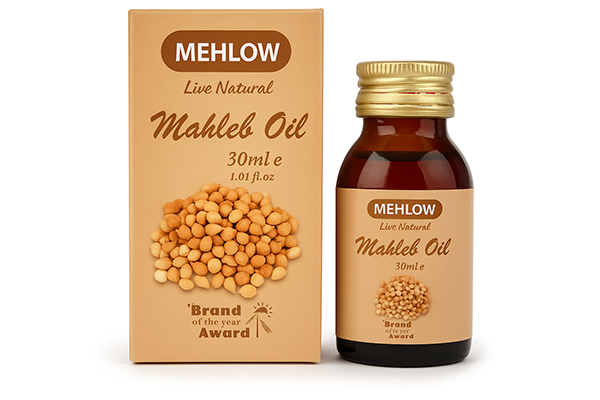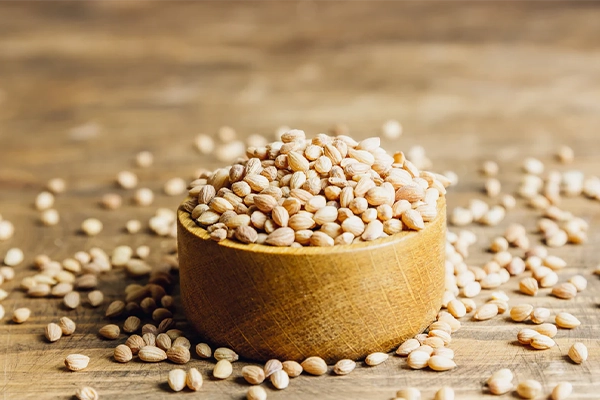Forms of Mahleb vary from whole seeds to finely ground powder and rich essential oil, each offering unique uses in baking, natural remedies, and cosmetic formulations. Whether you’re cooking, exporting, or crafting wellness products, understanding the different forms of Mahleb helps you choose the right one for your purpose.
Introduction
Mahleb, a traditional spice derived from the inner kernel of wild cherry seeds, has long held a special place in Middle Eastern and Mediterranean culture. Beyond its distinctive aroma and almond-cherry flavor, Mahleb is now gaining global recognition not just as a baking ingredient, but as a versatile product available in various forms. From fragrant Mahleb powder to nutrient-rich Mahleb oil and whole aromatic seeds, each form serves unique culinary, medicinal, and commercial purposes. In this comprehensive guide, we’ll explore the many forms of Mahleb, how each is produced, where it’s used, and what to consider when buying or exporting this golden seed.
What Is Mahleb?
Mahleb is a fragrant spice made from the seeds of the Prunus mahaleb tree, commonly known as the St. Lucie cherry. Hidden within the cherry pit is a small kernel that, when dried and ground, produces a powder with a unique flavor profile — a blend of bitter almond, cherry, and floral notes.
Traditionally used in Middle Eastern, Persian, and Mediterranean cuisine, Mahleb has been a key ingredient in festive breads, pastries, and dairy-based products like cheese. However, its applications now go far beyond the kitchen. As global interest in functional foods and natural remedies grows, Mahleb is being embraced for its nutritional value, aroma, and medicinal properties — making it an emerging star in international spice markets.
This versatile spice is available in different forms, including whole seeds, powder, and oil, each offering distinct advantages for culinary, wellness, and commercial purposes.
The Cultural and Historical Roots of Mahleb
Mahleb has a rich and ancient history rooted in the heart of the Middle East and the Mediterranean. For centuries, this spice has been valued not only for its flavor but also for its symbolic and medicinal significance. In Persia, it was often used in festive bread and sweets served during Nowruz and wedding ceremonies — symbolizing prosperity, fertility, and warmth.
The Greeks and Armenians also included Mahleb in ceremonial baked goods, such as tsoureki and cheoreg, which are traditionally prepared during religious holidays. Its use wasn’t limited to food; historical records and folk medicine texts mention Mahleb as a remedy for respiratory issues, digestive discomfort, and general fatigue.
This deep cultural heritage has helped Mahleb maintain its place in traditional kitchens and medicine cabinets across generations. Today, while modern production techniques have evolved, the roots of Mahleb remain strongly tied to heritage, craftsmanship, and regional identity — especially in countries like Iran, Turkey, Syria, and Lebanon.
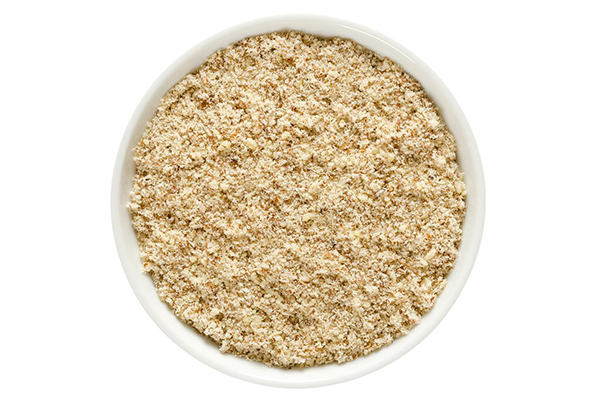
Forms of Mahleb: Overview
As Mahleb gains popularity in both culinary and wellness industries, it’s important to understand the various forms in which this spice is available. Each form serves a distinct purpose, depending on its texture, concentration, and method of processing.
The three most common forms of Mahleb on the market are:
- Whole Mahleb Seeds – The raw, natural form of the spice, often used in traditional grinding or infusions.
- Mahleb Powder – A finely ground version with a sweet, nutty aroma, ideal for baking and seasoning.
- Mahleb Oil – Extracted through cold pressing or solvent-free methods, used in cosmetics, herbal medicine, and high-value food products.
While all three forms originate from the same cherry kernel, their usage, shelf life, and commercial appeal can vary greatly. Choosing the right form depends on whether you’re baking bread, producing herbal supplements, or exporting bulk Mahleb to international markets.
In the next sections, we’ll take a closer look at each form and uncover what makes it valuable — both for consumers and for global trade.
Mahleb Powder: Production, Benefits & Recipes
Mahleb powder is the most widely used form of this aromatic seed. It’s made by cracking open the hard cherry pit, extracting the inner kernel, and grinding it into a fine, pale beige powder. The result is a spice with a delicate flavor — reminiscent of bitter almond and cherry blossom — that enhances both sweet and savory dishes.
🧪 How It’s Made
After harvesting, the wild cherry pits are dried and mechanically cracked. The kernels are then separated, lightly toasted to enhance aroma, and finely ground under low heat to preserve their essential oils and nutritional properties.
🍞 Culinary Uses
Mahleb powder shines in traditional pastries like Persian shirmal bread, Greek tsoureki, and Armenian cheoreg. It’s also used in cheese making, puddings, and sometimes sprinkled over fruit salads or yogurt. Just a small pinch transforms recipes with its warm, nutty complexity.
🌿 Health Benefits
Rich in antioxidants, essential fatty acids, and vitamins like E and C, Mahleb powder is said to support digestion, boost immunity, and even improve mood. It also contains fiber and calcium, making it a functional ingredient beyond just flavor.
👨🍳 Quick Recipe Idea:
Add ½ teaspoon of Mahleb powder to your next sweet bread or cookie dough to introduce a fragrant Middle Eastern twist. Pair it with cardamom or cinnamon for best results.
Mahleb Oil: Extraction & Applications in Pharma & Cosmetics
Mahleb oil is a premium extract derived from the kernels of wild cherry seeds. This golden-hued oil is highly valued for its aromatic richness, skin-nourishing properties, and therapeutic potential, making it a sought-after ingredient in the worlds of natural health and cosmetics.
🛠️ How It’s Extracted
There are two primary methods for extracting Mahleb oil:
- Cold-Pressing – Preserves the natural compounds and produces high-quality oil ideal for topical and culinary use.
- Solvent-Free Mechanical Extraction – A clean, industrial-scale method that ensures purity and safety for cosmetic and pharmaceutical applications.
Each method maintains the integrity of key nutrients like linoleic acid, oleic acid, tocopherols (Vitamin E), and plant sterols.
🧴 Applications in Cosmetics & Skincare
Thanks to its emollient and anti-inflammatory properties, Mahleb oil is used in:
- Natural moisturizers and anti-aging creams
- Hair oils for strengthening and shine
- Soothing balms for sensitive or irritated skin
Its pleasant, slightly almond-like scent also makes it ideal for luxury soaps and perfumes.
🌿 Pharmaceutical and Wellness Uses
In herbal medicine, Mahleb oil is believed to help:
- Relieve joint pain and inflammation
- Support respiratory health
- Enhance overall vitality through topical or oral supplementation (in small doses and under supervision)
💡 Export Note:
Because of its versatility and growing demand in clean beauty and wellness markets, Mahleb oil is an excellent product for value-added export. Proper packaging and certification can significantly boost its commercial appeal abroad.
Whole Mahleb Seeds – Traditional and Modern Usage
Whole Mahleb seeds are the raw, unprocessed form of this aromatic spice. Sourced directly from the stone of the wild black cherry (Prunus mahaleb), these small, oval-shaped seeds hold within them the flavor core of all Mahleb products. They’re prized for their purity and shelf life, especially in traditional markets where freshness and control over grinding are crucial.
🌾 Traditional Uses
In many cultures, whole Mahleb seeds are sold in local spice bazaars, where home cooks or artisanal bakers grind the seeds fresh before use. This method ensures a richer, more intense aroma — essential for holiday breads, traditional pastries, and religious feasts.
- In Iran, they are used during Nowruz celebrations.
- In Turkey and Syria, Mahleb is ground and mixed with nuts or sugar to create flavorful toppings.
- Some regions use them in infusions or herbal teas to soothe digestion and enhance mood.
🧴 Modern Applications
Whole seeds are also used in oil extraction, as raw material for Mahleb powder, and in herbal medicine preparations. Some health brands soak the seeds in glycerin or alcohol to create Mahleb tinctures for internal or topical use.
📦 Packaging & Export Benefits
Whole Mahleb seeds have the longest shelf life of all forms. They’re often exported in:
- Vacuum-sealed kraft pouches
- Jars with moisture absorbers
- Bulk sacks for industrial processors
This form appeals to distributors, herbalists, and manufacturers looking for customization or freshness.
Culinary Applications Around the World: From Iran to the Mediterranean
Mahleb has long been a secret weapon in the kitchens of the Middle East, the Mediterranean, and Central Asia. Its unmistakable flavor — a mix of cherry, almond, and floral spice — has made it a cherished ingredient in both savory and sweet dishes.
🇮🇷 Iranian Cuisine
In Iran, Mahleb powder is traditionally used in shirmal (saffron bread), local sweet breads, and even mixed with cardamom and cinnamon in pastries. Some rural regions also use Mahleb in herbal dairy-based drinks.
🇹🇷 Turkey
Known as Mahlep, it is a staple in Turkish poğaça (savory pastries), acma (soft rolls), and various Ramadan treats. Bakers believe Mahleb enhances aroma and improves texture.
🇬🇷 Greece
In Greece, Mahleb (mahlepi) is central to tsoureki, a festive braided bread baked for Easter. Combined with mastic and orange zest, it gives this bread its characteristic scent and chew.
🇦🇲 Armenia
Armenians use Mahleb in cheoreg, a rich, slightly sweet bread often served during holidays. It’s also included in some traditional cookies and cakes.
🌍 Other Culinary Innovations
- Europe & U.S.: Artisan bakers and chefs are now using Mahleb powder in cookies, granola, and energy bars.
- North Africa: Some herbalists and chefs steep Mahleb seeds in milk or tea blends for digestive relief and aroma.
- Gourmet Chocolate & Ice Cream: Mahleb pairs beautifully with white chocolate, cherry, and pistachio flavors.
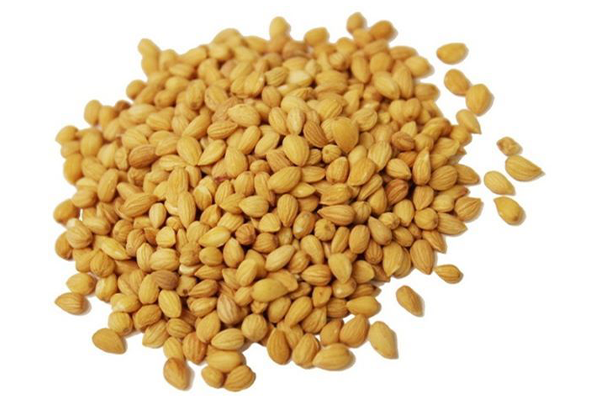
Mahleb in Traditional Medicine & Natural Remedies
Beyond the kitchen, Mahleb has long been celebrated in folk medicine for its healing properties. Ancient Persian, Greek, and Arab herbal texts reference Mahleb as a tonic for digestion, a relaxant for the nervous system, and even a gentle remedy for respiratory and joint issues.
🌿 Digestive Aid
Mahleb powder and seed infusions have been used to soothe bloating, cramping, and indigestion. Its natural oils help relax the gut and support better nutrient absorption.
🧠 Mood and Sleep Support
Thanks to its mild sedative effects, Mahleb tea has traditionally been used to reduce anxiety and promote restful sleep — particularly when blended with cardamom, rose, or saffron.
💪 Anti-Inflammatory & Pain Relief
Both Mahleb oil and seed paste have been used topically to relieve muscle pain, joint inflammation, and skin irritations. These uses are supported by its rich antioxidant and fatty acid profile.
🫁 Respiratory Soother
In traditional Syrian and Lebanese practices, Mahleb is sometimes steeped with honey or lemon to relieve dry coughs and sore throats.
⚠️ While these remedies have stood the test of time, scientific research is still growing. Always consult a qualified practitioner before therapeutic use.
How to Choose the Right Form of Mahleb for Your Needs
With Mahleb available in different forms — seeds, powder, and oil — choosing the right one depends entirely on your goals: Are you baking at home? Running a cosmetic line? Or sourcing ingredients for export?
🍞 Choose Mahleb Powder If You Are:
- A baker looking for aromatic spice to elevate breads, cookies, and desserts.
- A food brand wanting to add Middle Eastern flavor to packaged goods.
- A tea or spice shop importing ready-to-use culinary products.
🧴 Choose Mahleb Oil If You Are:
- A cosmetics brand seeking natural, antioxidant-rich oils for skincare or haircare.
- A wellness company formulating herbal balms or tinctures.
- An importer looking for high-margin, niche health products.
🌰 Choose Whole Mahleb Seeds If You Are:
- A traditional herbalist or spice trader who prefers maximum freshness and shelf life.
- A processor or exporter planning to grind or extract Mahleb locally.
- A bulk buyer in need of raw material for various applications.
By matching the form to the function, you ensure optimum flavor, health value, and profitability — whether you’re preparing artisan breads or launching a natural cosmetics line.
How Each Form Is Packaged for Export (Retail vs. Bulk)
When exporting different forms of Mahleb, packaging plays a crucial role in maintaining freshness, quality, and shelf life. Each form—whether it’s whole seeds, powder, or oil—requires distinct packaging methods tailored to its texture, volatility, and market destination.
Retail Packaging:
For consumer markets, Mahleb is often packed in small, sealed containers, usually ranging from 50g to 500g. These retail packs are typically made from PET jars, vacuum-sealed foil pouches, or resealable kraft paper bags with food-grade linings. The aim is to protect the product from moisture, light, and oxidation while offering a visually appealing look for store shelves. Labels often include nutritional info, certifications (like organic or ISO), and usage instructions.
Bulk Packaging for Export:
Exporters and suppliers dealing with bulk orders—especially for bakeries, pharmaceutical companies, or spice distributors—often use multi-layer paper sacks (10kg–25kg), food-grade drums, or vacuum-sealed large plastic bags placed inside corrugated boxes. For Mahleb oil, dark glass bottles or metal tins with tamper-evident caps are used to preserve its chemical stability during long-haul transport.
Sustainability & Branding Considerations:
Many premium Mahleb exporters are shifting toward eco-friendly and biodegradable packaging to meet global demand for sustainable practices. Bulk buyers also seek custom-printed sacks or private label options, allowing them to resell Mahleb under their brand.
At Mehlow, we offer fully customizable packaging solutions tailored to each form of Mahleb—ensuring freshness, global compliance, and strong brand presence in international markets.
Comparing the Forms: Which One Is Best for You?
Choosing the right form of Mahleb depends heavily on your intended use—culinary, medicinal, or commercial. Each variation offers unique advantages in terms of flavor intensity, shelf life, and convenience.
Whole Seeds
Whole Mahleb seeds retain the highest level of freshness. They are perfect for those who prefer grinding seeds fresh to release the most potent aroma and nutrients. Ideal for artisanal bakers and traditional recipe applications, this form has a longer shelf life and is less prone to oxidation.
Ground Mahleb (Powder)
This is the most popular and versatile form. Powdered Mahleb is convenient for quick use in baking, spice blends, and desserts. However, it has a shorter shelf life than whole seeds and should be stored in airtight containers away from light and humidity. Best for home cooks and food processors.
Mahleb Oil
Extracted via cold-press or solvent methods, Mahleb oil is rich in phenolic compounds and is often used in cosmetics, aromatherapy, and natural medicine. It is potent and concentrated, offering unique applications beyond the kitchen. It requires careful storage and handling due to its sensitivity to light and heat.
Mahleb Extract & Capsules
A modern pharmaceutical adaptation, these are suitable for nutritional supplementation and used in traditional and functional medicine. They offer ease of dosage and controlled potency but are not typically used in culinary applications.
Each of these forms of Mahleb caters to a specific audience—from gourmet chefs and home bakers to herbalists and cosmetic producers. Selecting the best form depends on the balance between intended use, storage capacity, and preparation preferences.
Mahleb and Modern Innovation: New Product Trends
In recent years, the global demand for natural, functional ingredients has pushed Mahleb into the spotlight—not just as a traditional spice, but as a modern super-ingredient. This shift has led to new trends in both product innovation and cross-industry applications.
Fusion in Gourmet Foods
From high-end bakeries in Paris to modern Middle Eastern fusion cuisine, Mahleb is now being used in savory dishes, artisan cheeses, and infused oils. Some gourmet brands even incorporate Mahleb into flavored butter, chutneys, or dessert sauces, taking advantage of its cherry-almond aroma.
Mahleb in Health & Wellness Products
The medicinal benefits of Mahleb have led to the development of herbal teas, functional snacks, and natural supplements. Some wellness brands use Mahleb powder in protein bars, antioxidant capsules, and herbal infusions targeting digestion, immunity, and inflammation.
Cosmetic Applications
Thanks to its rich antioxidant and phenolic profile, Mahleb oil is becoming an ingredient in natural skincare products, including serums, balms, and hair treatments. These products benefit from its antimicrobial and anti-aging properties, especially when cold-pressed and unrefined.
Private Label & Export Branding
Exporters and manufacturers, including Mehlow, are now developing custom-branded Mahleb products tailored for foreign markets. This includes ready-to-use Mahleb sachets, gift boxes for spice collectors, and specialized export lines for Middle Eastern grocery chains and wellness boutiques.
Innovation in Mahleb products isn’t just about new recipes—it’s about redefining tradition for the global market.
Common Misconceptions About Mahleb Products
Despite its growing popularity, Mahleb is still surrounded by several misunderstandings that can confuse consumers and buyers—especially those new to this traditional spice. Let’s break down the most common misconceptions about different forms of Mahleb.
Misconception 1: All Mahleb Tastes the Same
The flavor of Mahleb can vary significantly depending on the form. Whole seeds, when freshly ground, deliver a stronger and more aromatic flavor compared to pre-ground powder. Also, Mahleb oil has a distinctly intense essence that’s not suitable for general cooking.
Misconception 2: Mahleb Powder Lasts Forever
Unlike whole seeds, Mahleb powder loses its potency over time—especially if exposed to air, light, or moisture. Many consumers mistakenly believe they can store it like other dry spices, but Mahleb powder is far more delicate and should be consumed within a few months of opening.
Misconception 3: All Mahleb Is Suitable for Eating
Some forms—like bitter wild seeds or industrial-grade oil—may not be food-safe or suitable for culinary use. Only food-grade Mahleb should be used in baking or seasoning, and it’s essential to source it from trusted suppliers like Mehlow.
Misconception 4: Mahleb Is Just a Spice for Bread
While Mahleb is famous for its use in traditional pastries like Greek tsoureki or Armenian choereg, it is far more versatile. It’s used in desserts, beverages, cosmetics, and even pharmaceutical products, depending on the form.
Misconception 5: Mahleb from All Regions Is Equal
Mahleb cultivated in Iran and the Levant often has a higher oil content and richer aroma, compared to mass-produced alternatives. The source matters—and so does the processing method.
Clearing up these misconceptions not only helps consumers make informed decisions but also highlights the importance of quality, authenticity, and intended usage when purchasing or exporting Mahleb products.
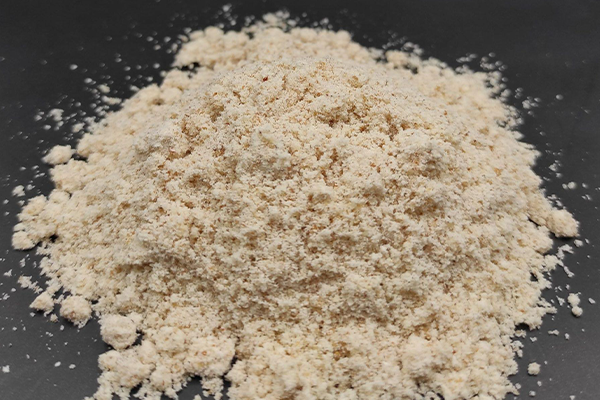
Where to Buy Authentic Mahleb: Supplier Tips
For both individual consumers and bulk buyers, sourcing authentic forms of Mahleb can be a challenge. The market is full of low-quality imitations, adulterated powders, or improperly stored products that lose their flavor and potency. Here’s how to ensure you’re buying the real deal:
✅ Buy Directly from Origin-Based Producers
The best Mahleb comes from regions where it has been traditionally cultivated — such as Iran, Syria, and parts of Turkey. Buying directly from local producers or certified exporters in these countries reduces the risk of contamination or fraud. At Mehlow, we source and process Mahleb directly from trusted Iranian farms.
✅ Look for Third-Party Certifications
Authentic Mahleb products often carry food safety certifications like ISO, HACCP, or organic labels. These certifications ensure the product has been handled and processed under hygienic and industry-standard conditions.
✅ Choose the Right Packaging
Proper packaging preserves aroma and shelf life. Avoid products in loose plastic bags or unsealed containers. Instead, opt for Mahleb in foil pouches, dark jars, or sealed kraft bags. This is especially important for Mahleb oil, which is sensitive to light and heat.
✅ Check for Freshness & Color
Whole Mahleb seeds should be creamy to pale brown, not dark or shriveled. The powder should have a sweet, slightly almond-cherry aroma. If the smell is musty or faint, the product may be old or improperly stored.
✅ Avoid Unlabeled or Generic Products
If the packaging doesn’t list the country of origin, expiry date, or nutritional information, it’s a red flag. Stick to reputable brands and exporters that value transparency.
📦 Tip: For bulk buyers and resellers, Mehlow offers customizable packaging, private labeling, and global shipping — ensuring high-quality Mahleb reaches your market, intact and fresh.
Conclusion: From Ancient Spice to Global Ingredient
The various forms of Mahleb—from whole seeds and fine powder to potent oils—represent more than just a spice. They reflect centuries of culinary tradition, medicinal use, and now, a growing presence in global trade and innovation. Whether you’re a chef, a wellness brand, or an international distributor, Mahleb offers unmatched versatility and cultural richness.
Understanding the differences between Mahleb forms, their best applications, and sourcing tips can help you harness its full potential. It’s not just about buying a spice—it’s about tapping into a story of heritage, health, and innovation.
Bring Premium Mahleb to Your Market
Looking to source authentic Mahleb in bulk or under your own brand?
At Mehlow, we offer premium-grade Mahleb in all its forms—whole, powdered, and oil—with custom packaging, global logistics support, and full quality certification.
👉🏼 Contact us now to request a free export consultation or a sample pack tailored to your target market.
Let’s turn ancient flavor into modern opportunity.
FAQ Section
What are the most common forms of Mahleb used today?
The most common forms of Mahleb include powder, oil (cold-pressed and extracted), whole seeds (raw, roasted, ground), and pharmaceutical capsules or extracts.
Is Mahleb powder the same as ground seeds?
Not exactly. Mahleb powder is finely milled and often used in baking and desserts, while ground seeds can be coarser and may retain more of the nutty flavor.
Which form of Mahleb is best for export purposes?
Cold-pressed Mahleb oil and bulk powder are among the most export-friendly forms due to their longer shelf life and high market demand.
Can Mahleb oil be used in cosmetics or pharmaceuticals?
Yes, especially cold-pressed Mahleb oil is valued for its antioxidants and is often included in skincare, hair care, and even topical anti-inflammatory formulas.
What’s the difference between cold-pressed and extracted Mahleb oil?
Cold-pressed oil retains more nutrients and aroma, while extracted oil may have higher yield but could involve solvents, making it less desirable for health-conscious buyers.
How can I identify high-quality Mahleb products?
Look for reputable suppliers who provide certificates of origin, lab-tested purity, and clear labeling of the Mahleb form (powder, oil, seed, etc.).
Are there health benefits unique to each Mahleb form?
Yes, each form has unique properties: oil is rich in antioxidants, powder supports digestion, and seeds offer fiber and minerals.
Can I use different forms of Mahleb in one recipe?
In some cases, yes. For example, oil and powder can complement each other in baked goods, enhancing both flavor and nutritional value.

